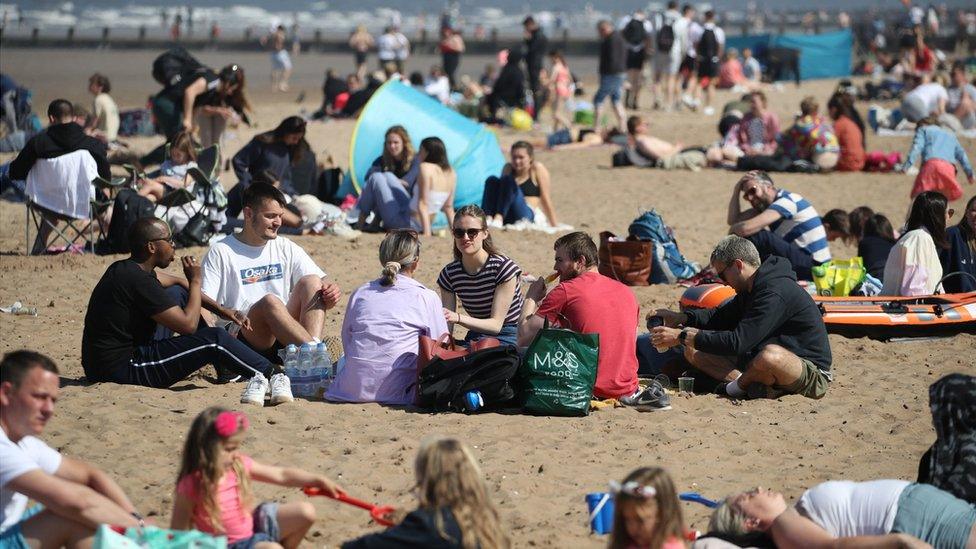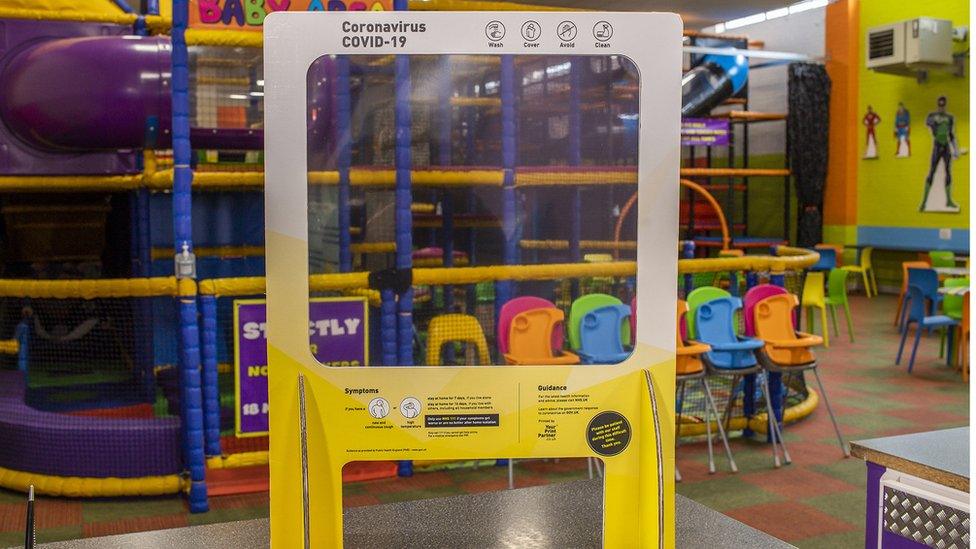Covid in Scotland: Decision due on next stage of lockdown easing
- Published

Portobello beach was a popular destination as temperatures soared on Monday
Nicola Sturgeon will confirm whether the next stage of Scotland's lockdown easing can go ahead next week.
Under the government's roadmap, areas in level two are due to move to level one from 7 June.
But Health Secretary Humza Yousaf has warned there may been a delay for parts of the country where Covid cases are rising rapidly.
Level one rules allow greater numbers of people to socialise and venues such as soft play centres to open.
The first minister is due to make a statement to MSPs on Tuesday afternoon.
All mainland council areas are currently in level two, with the exception of Glasgow - which remained under level three restrictions because of an upsurge of cases in the south of the city. This is believed to have been driven by the B.1.617.2 variant, first identified in India.
Ms Sturgeon said last week she was hopeful the city would finally be able to move down to level two from Saturday 5 June, allowing indoor household visiting and alcohol to be served indoors in pubs and restaurants after nine months of tough restrictions.
On Monday, Mr Yousaf indicated that for some areas currently in level two, the planned move to level one from Monday 7 June may have to be delayed if case rates were high and giving cause for concern.
The Scottish Conservatives have called for the whole country to be moved to level one, and said Ms Sturgeon should rule out "leaving whole areas behind".
The party's leader, Douglas Ross, said the council-wide approach to restrictions should be replaced with targeted interventions in smaller areas to tackle local outbreaks.
He added: "Sweeping measures that unnecessarily hurt a whole city or council area are unfair on businesses and local people waiting to get on with their lives.
"For the sake of jobs, businesses and people's mental health, the country has to move forward together as much as possible."

Which areas have highest case rates?

Renfrewshire and East Renfrewshire both currently have case rates higher than Glasgow.
Concern has recently been raised about rising infections in Dundee, which have increased from a very low level in a relatively short space of time.
A seven-day average case rate of 50 per 100,000 people has previously been seen as a threshold for a move from level three to level two, while 20 cases per 100,000 is the target for level one easing.
But a range of indicators are taken into account such as the impact on hospital admissions or whether community transmission is widespread.
The actual number of cases has also guided decisions, such as when East Renfrewshire was allowed to move down to level two, despite a high case rate, because the numbers were still relatively low.
In the past seven days City of Edinburgh has seen 401 new cases, while South Lanarkshire has seen 236 positive tests and North Lanarkshire has seen 231.
Glasgow City continues to have the highest number of cases - 815 in the past week - but the figures have fallen for four consecutive days.

James Chalmers, professor of respiratory research at the University of Dundee, said he thought it was "very unlikely" that all areas of Scotland would move to the same level this week.
"The country has not seen uniform rising cases. We've seen significant outbreaks, initially in areas like Moray, and in Glasgow and the west of Scotland - and now rising case in places like Dundee," he told BBC Radio's Good Morning Scotland programme.
Prof Chalmers said "recent evidence" showed that keeping certain areas in a higher level was working to contain big outbreaks.
"Moray had very high rates, the highest in the country. We saw surge vaccination and we saw really impressive efforts from the public health teams to get the cases down and that was effective," he said.
"Similarly, Glasgow had rapidly rising rates and by leaving Glasgow in level three and, again, surge vaccination, surge testing, cases haven't risen exponentially in Glasgow as they might have done last year."
What changes in level one?
Some islands in Scotland are already in level one which allows greater numbers to socialise.
For indoor public places such as cafes, pubs or restaurants the limit rises to eight people from three households, while outdoors 12 people from 12 different households can meet up.

Soft play centres have been some of the last businesses to be given the go-ahead to reopen
Soft play centres and funfairs are allowed to reopen, with only nightclubs and adult entertainment having to remain closed.
The number of people allowed to attend weddings or funerals rises to 100 under level one rules.
Pubs and restaurants are permitted to serve alcohol until 23:00, rather than 22:30 under level two.
Under current guidance, the limit on indoor gatherings in private homes remains at six people from three households, as in level two, and people would still be encouraged to work from home where possible.

'We've been shut for more than 450 days'

Jennifer McNaughton fears for the future of soft play businesses
Jennifer McNaughton is soft play manager at Pandamonium in Renfrewshire - the council area which currently has the highest Covid rate in Scotland.
She is hoping to get the go-ahead to reopen next week, and says it will be "devastating" if the area stays in level two.
"We have been shut for more than 450 days. What other businesses have really been shut that length of time?" she told BBC Scotland.
She said the business made a decision on Monday, after talking to the Scottish government, to accept bookings again.
"We had to make our bookings live because if we opened we wouldn't have had anyone coming in through the door.
"So we've got 24 parties booked and over 100 people booked to come into the centre all next week - and if we don't get opened we're going to have to let all these little kids down."
She said staff had been working for the past six weeks to prepare the centre for reopening.
"The only support that's there for the business right now is furlough - but there has to be a business there for furlough to be beneficial.... we can't sustain it, we can't keep going - there will be no soft plays for children."

